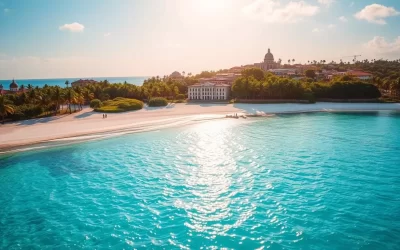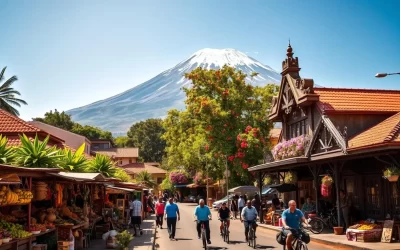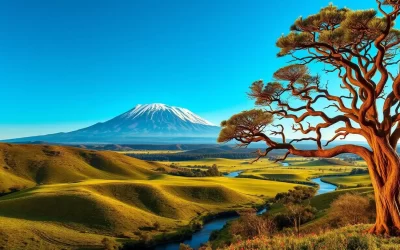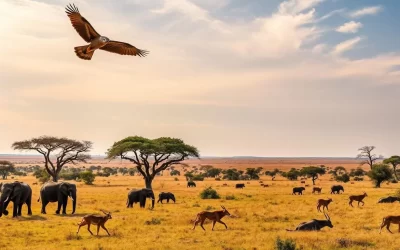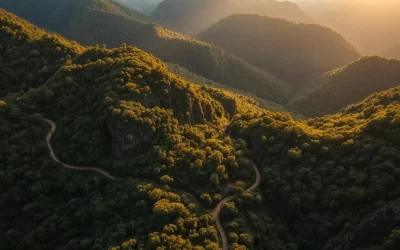Nestled in western Tanzania, Mahale Mountains National Park is a pristine wilderness area that stands out for its breathtaking landscapes and diverse wildlife. Spanning 1,600 square kilometers, the park boasts mountains covered in lush jungle, rising to peaks as high as 2,400 meters, and is bordered by the crystal-clear shores of Lake Tanganyika, the second-deepest lake in the world.
As you explore this national park, you’ll discover an extraordinary blend of experiences, from trekking to encounter habituated chimpanzees to relaxing on the beach or hiking through the forested mountains. With approximately 1,000 chimpanzees calling the park home, it’s a premier destination for observing these primates in their natural habitat. The park’s remoteness contributes to its unspoiled nature, making it an ideal location for a unique and unforgettable safari experience.
Discovering Mahale Mountains National Park
Mahale Mountains National Park, located on the shores of Lake Tanganyika, offers an unforgettable wilderness experience. This remote national park in western Tanzania is known for its pristine wilderness and diverse ecosystems.
Location and Geography
Mahale Mountains National Park is situated in western Tanzania, along the eastern shores of Lake Tanganyika. The park’s geography is characterized by mountains rising to 2,400 meters above sea level, creating diverse ecological zones from the lakeshore to alpine areas. The lower slopes are covered with a lush forest composed of nutmeg, mahogany, silk, and fig trees, while the upper slopes feature brittlewood, rushfoil, pines, and bamboo wilderness.
Unique Features of the Park
The park’s proximity to Lake Tanganyika creates a unique ecosystem where forest meets beach, offering visitors diverse landscapes in one destination. The lake itself is home to about 250 different fish species, adding to the park’s rich biodiversity. The park is also renowned for its chimpanzee populations and other wildlife, making it a significant conservation area.
| Feature | Description |
|---|---|
| Location | Western Tanzania, along Lake Tanganyika’s shores |
| Geography | Mountains rising to 2,400 meters, diverse ecological zones |
| Ecosystem | Forest meets beach, rich biodiversity |
| Wildlife | Chimpanzees, various fish species in Lake Tanganyika |

Chimpanzee Trekking – The Ultimate Experience

In the heart of Tanzania, Mahale Mountains National Park offers a unique chimpanzee trekking experience that is unparalleled in Africa. This signature activity allows visitors to venture into the forest in search of the park’s resident chimpanzees, providing an adventure that is both exhilarating and educational.
Meeting the Mimikire Clan
The Mimikire clan, also known as the M-group, has been the subject of research for decades, making them one of the most habituated chimpanzee groups in Africa. This 56-member group is remarkably comfortable with human presence, often approaching visitors. The familiarity between the chimps and humans creates a truly immersive experience.
What to Expect During a Trek
Your day begins with a morning briefing, followed by a hike into the forest where experienced guides and trackers lead you to the chimpanzees. The trek can range from a leisurely 30-minute walk to a more challenging 3-hour hike, depending on the chimps’ location and the season. Upon finding the chimpanzees, visitors are allowed a one-hour observation period, during which they can witness a variety of behaviors, from grooming and feeding to playful antics and tool use.
To ensure a safe and enjoyable experience for both humans and chimps, strict rules are enforced, including maintaining a safe distance, wearing masks, and limiting the viewing time. The experience is not only thrilling but also educational, thanks to the insights provided by the guides who interpret chimpanzee behaviors and communications.
As you trek through the forest, it’s essential to be prepared with the right gear, including sturdy hiking boots, long pants, rain gear, and a camera with a fast lens to capture the moments in the sometimes challenging forest light.
Best Time to Visit Mahale Mountains National Park
Understanding the seasonal variations in Mahale Mountains National Park is key to making the most of your safari. The park’s climate significantly influences the behavior of its wildlife, particularly the chimpanzees, and thus affects the overall experience.
Dry Season Advantages
The dry season, from May to October, is generally considered the best time to visit Mahale Mountains National Park. During this period, chimpanzees tend to stay at lower elevations and often approach the lakeside, making them easier to track. This results in shorter treks, sometimes as brief as 30 minutes. The dry conditions also mean clearer trails, less mud, and a reduced risk of rainfall interrupting activities. Moreover, the lower water levels in Lake Tanganyika during this season make the waters clearer, ideal for swimming and snorkeling.
Wet Season Considerations
While the wet season presents some challenges, it also has its advantages. The landscapes are lush and green, and there are fewer visitors, which might appeal to those seeking a more secluded experience. However, chimpanzees tend to move to higher elevations in search of certain fruits, potentially making treks more strenuous and longer, sometimes up to 3 hours.
| Characteristics | Dry Season (May-October) | Wet Season (November-April) |
|---|---|---|
| Chimpanzee Tracking | Easier, shorter treks (sometimes 30 minutes) | More challenging, longer treks (up to 3 hours) |
| Trail Conditions | Clearer trails, less mud | Muddy trails, potentially more challenging |
| Lake Tanganyika | Lower water levels, clearer waters | Higher water levels, potentially murkier waters |
| Landscape | Dryer landscapes | Lush, green landscapes |
| Visitor Numbers | More visitors | Fewer visitors |
| Rainfall | Less risk of rainfall interrupting activities | Short afternoon showers, but possible disruptions |

Exploring Lake Tanganyika’s Crystal Waters
With its pristine sandy beaches and crystal-clear waters, Lake Tanganyika is an ideal spot for relaxation and adventure. As the second-deepest and second-largest lake globally, it contains 8% of the world’s freshwater, making it a unique destination.
Swimming and Snorkeling Opportunities
You can enjoy swimming in the lake’s crystal-clear waters, cooling off after a hot chimpanzee trek. The best swimming spots are often near the lodges, where you can relax on the sandy shores. Snorkeling in Lake Tanganyika offers a unique experience, with hundreds of colorful cichlid fish species to observe, creating a freshwater aquarium-like environment.
- Refresh in the lake’s crystal-clear waters
- Explore the diverse fish species while snorkeling
- Relax on the pristine sandy beaches
Fishing Excursions on the Lake
Fishing excursions on Lake Tanganyika offer a range of experiences, including catch-and-release sport fishing. You can try to catch species like Nile perch, lake sardines, and various cichlids. Additionally, sunset boat trips and dhow sailing experiences allow you to appreciate the lake’s vastness and the dramatic backdrop of the Mahale Mountains from the water.
- Enjoy catch-and-release sport fishing
- Catch various fish species, including Nile perch and cichlids
- Take in the breathtaking views during sunset boat trips
While enjoying water activities, it’s essential to be aware of safety considerations, including the presence of hippos and crocodiles in certain areas. Your guides will ensure your safety during these excursions.
Wildlife Viewing Beyond Chimpanzees
While chimpanzees are a main attraction, the park’s rich biodiversity offers much more to explore. Mahale Mountains National Park is home to a diverse range of wildlife that enhances your safari experience.
Other Primates in the Forest
The forest is inhabited by various primate species, including the striking black-and-white colobus monkeys, red-tailed monkeys, blue monkeys, and yellow baboons. These species exhibit fascinating behaviors and habitat preferences, adding to the richness of your forest experience. Other mammals such as forest antelopes, bushbucks, porcupines, and various squirrel species contribute to the park’s biodiversity.
Bird Watching Opportunities
Mahale Mountains National Park is a birdwatcher’s paradise, with over 350 bird species recorded. Notable species include Ross’s turaco, crested guineafowl, African fish eagles, and various kingfishers. The varied habitats, from lakeshore to mountain peaks, create different ecological niches that support a wide range of birdlife.
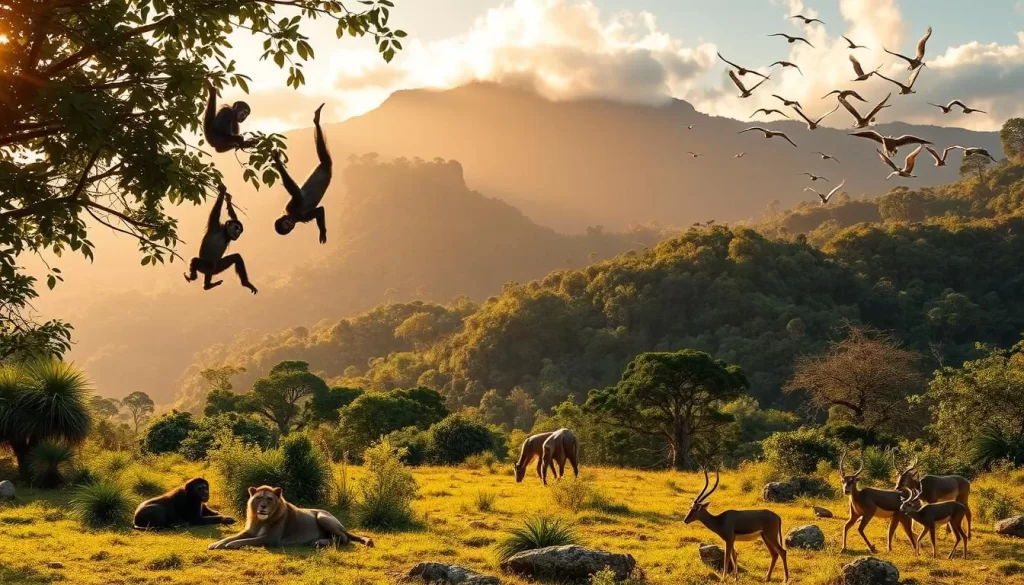
| Wildlife Category | Examples |
|---|---|
| Primates | Black-and-white colobus monkeys, red-tailed monkeys, blue monkeys, yellow baboons |
| Birds | Ross’s turaco, crested guineafowl, African fish eagles, kingfishers |
| Forest Mammals | Forest antelopes, bushbucks, porcupines, squirrels |
Hiking the Mahale Mountains
Beyond chimpanzee trekking, the Mahale Mountains offer a thrilling adventure through diverse forest ecosystems and breathtaking viewpoints. The range allows you to explore various trails, from leisurely walks near the lakeshore to more challenging full-day expeditions to higher elevations, reaching up to 2,400 meters.
Popular Trails and Routes
The Kasoje River Trail is a favorite among hikers, following the river through lush forest, where you can spot various primates, birds, and butterflies. For a more challenging hike, the trail to Mahale’s peaks rewards trekkers with panoramic views of Lake Tanganyika and the surrounding landscape, making it a photographer’s dream. As you ascend, the changing wilderness vegetation zones offer a unique experience, from mahogany and fig trees to bamboo forests and moorland vegetation.
What to Pack for Mountain Hikes
When preparing for mountain hikes, it’s essential to pack properly. This includes wearing proper footwear, lightweight long pants and shirts for protection, rain gear, sun protection, water bottles, and camera equipment. Hiring experienced local guides is also crucial as they can navigate the trails, identify wildlife and plants, and share knowledge about the mountain ecosystem.
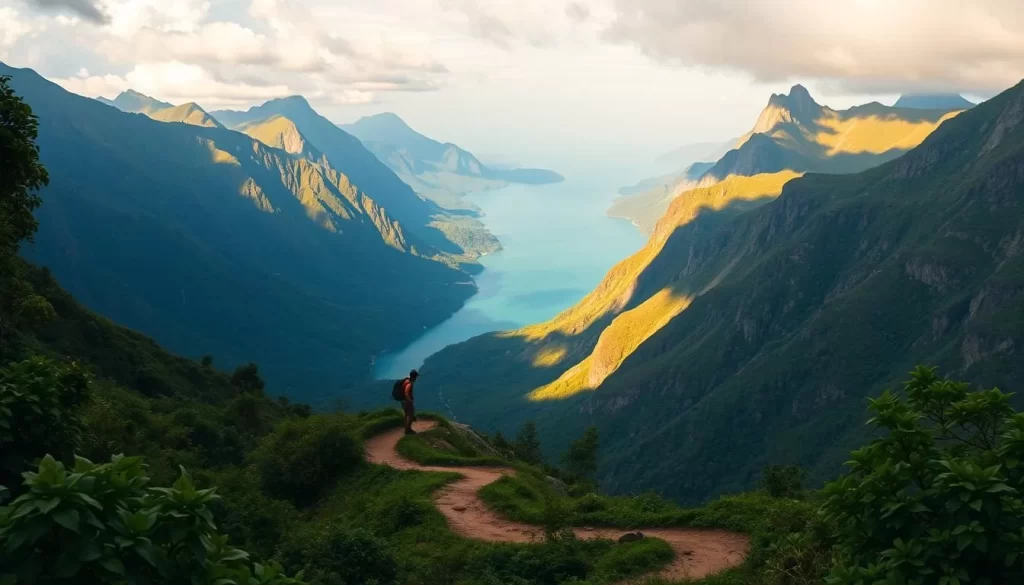
Beach Relaxation Along Lake Tanganyika
The turquoise waters of Lake Tanganyika lap gently against golden sand beaches, creating a tranquil oasis. You can unwind on these pristine shores, enjoying the serene atmosphere that contrasts with the more active pursuits like chimpanzee trekking and hiking.
Golden Sand Beaches
The beaches along Lake Tanganyika’s shores offer perfect spots for relaxation. You can swim in the crystal-clear waters, sunbathe on the soft sands, or simply relax with a book. The beach areas near the lodges are ideal for these activities, providing a balanced safari experience. The beaches also serve as natural platforms for observing lake wildlife, including water birds and occasional hippos.
Sunset Viewing Spots
As the day ends, the sunset viewing spots along Lake Tanganyika become particularly captivating. The sun sinks behind the Congo mountains, creating dramatic orange and red skies. You can enjoy sundowner drinks, beach bonfires, and stargazing, taking advantage of the minimal light pollution. The changing moods of the lake throughout the day create different atmospheres, from morning mist to evening calm, enhancing your overall experience.
| Activity | Location | Best Time |
|---|---|---|
| Swimming | Beach near lodges | Morning/Afternoon |
| Sunset Viewing | Lake shoreline | Evening |
| Stargazing | Beach | Night |
Where to Stay in Mahale Mountains National Park
As you prepare for your adventure in Mahale Mountains National Park, finding the ideal accommodation is essential for a comfortable and enriching stay. The park offers limited yet exceptional accommodation options that complement its pristine wilderness.
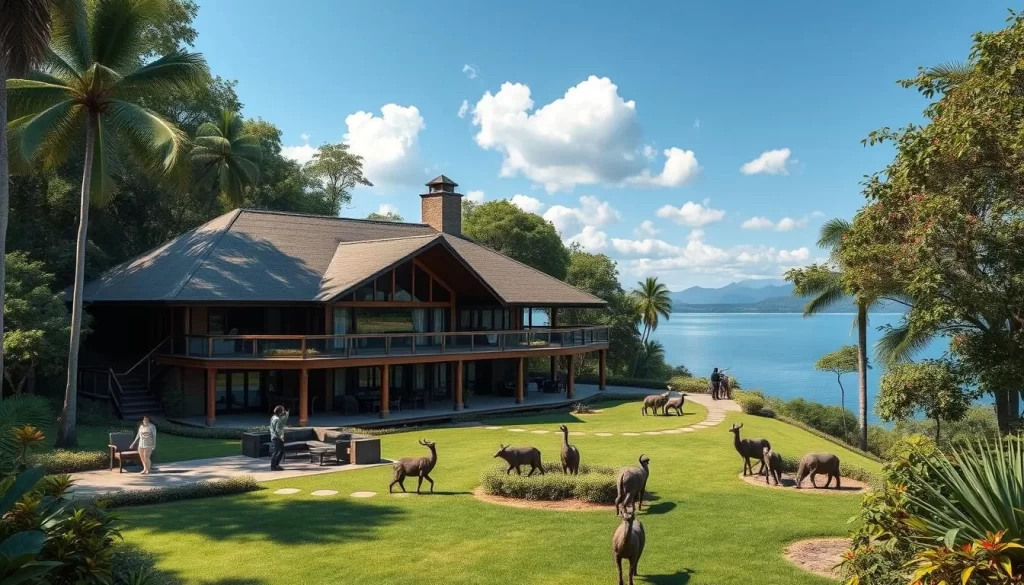
Greystoke Mahale Lodge
Greystoke Mahale Lodge is the premier accommodation option, boasting a distinctive castaway-chic design with bandas made from reclaimed dhow wood. Its spectacular beachfront location on Lake Tanganyika’s golden sands makes it one of Africa’s most unique safari lodges. The lodge offers an experience like no other, with an excellent guiding team and gourmet dining featuring fresh lake fish.
Guests can enjoy signature experiences such as sundowners on a dhow and dining on the beach under the stars, making for an unforgettable safari adventure.
Mbali Mbali Mahale
For those seeking an alternative, Mbali Mbali Mahale offers nine beach tents that blend comfort with the natural surroundings, providing a perfect balance of elegance and authenticity. This lodge is situated on the shores of Lake Tanganyika, next to Mahale Mountains National Park, and seeks to offer the ideal destination for your safari.
Mbali Mbali Mahale provides a serene experience with various activities and dining options, making it an excellent base for exploring Mahale’s attractions and enjoying the beauty of Lake Tanganyika.
Both lodges prioritize sustainability, using solar power, conserving water, and engaging with the local community to minimize their environmental impact. It’s recommended to book at least 6-12 months in advance due to the limited accommodation options and logistics of reaching these remote lodges.
How to Get to Mahale Mountains National Park
Reaching Mahale Mountains National Park is an adventure in itself, requiring meticulous planning due to its remote location in western Tanzania, far from popular Tanzania safari circuits near Mount Kilimanjaro and Ngorongoro Crater.
Flight Options
The journey typically begins with international flights to either Julius Nyerere International Airport in Dar es Salaam or Kilimanjaro International Airport near Arusha. From there, domestic connections are available. Safari Air Link offers a twice-weekly service between Ruaha, Katavi, and Mahale. Additionally, Zantasair provides shared charter flights between northern Tanzania and western Tanzania, partnering with its sister company, Mbali Mbali lodges.
Transportation Within the Park
Once you arrive at the airstrip, a boat transfer takes you to the lodges along Lake Tanganyika, offering scenic views and potential wildlife sightings. Movement within the park is primarily by boat along the lakeshore, while forest activities are conducted on foot. It’s advisable to work with experienced tour operators to coordinate the complex transportation arrangements.
| Transportation Method | Description | Approximate Time |
|---|---|---|
| International Flight | To Dar es Salaam or Arusha | Varies |
| Domestic Flight | To Mahale airstrip | 1-2 hours |
| Boat Transfer | From airstrip to lodges | 30 minutes |
Combining Mahale With Other Tanzania Destinations
For a well-rounded Tanzanian adventure, consider combining Mahale with other national parks and reserves. This approach allows you to experience the country’s diverse ecosystems, from forest habitats to savannas and wetlands.
Katavi National Park Connection
One of the most compelling combinations is pairing Mahale Mountains National Park with Katavi National Park. This classic western Tanzania circuit offers both primate encounters in Mahale’s forests and traditional big game viewing in Katavi’s vast plains. Katavi National Park is known for its large hippo concentrations and excellent predator sightings, making it a perfect complement to Mahale’s unique chimpanzee trekking experience. Practical logistics are simplified by scheduled flights between the parks and the option to stay at sister camps operated by the same companies, such as Nomad Tanzania’s Greystoke Mahale and Chada Katavi.
Northern Tanzania Safari Circuit
Alternatively, you can combine Mahale with the Northern Tanzania safari circuit, which includes famous destinations like the Serengeti, Ngorongoro Crater, and Tarangire National Park. This combination allows travelers to experience both Tanzania’s renowned savanna ecosystems and its unique forest habitats. To connect Mahale with Northern Tanzania, flight connections through Arusha are recommended. You can also consider an off-the-beaten-path safari that includes Ruaha National Park and Nyerere National Park (formerly Selous) in southern Tanzania, covering three distinct ecosystems.
Sample itineraries can help structure a multi-destination Tanzania safari. For instance, a week-long trip can include both Mahale Mountains National Park for chimpanzee trekking and Katavi National Park for Big Five game viewing. By carefully planning your itinerary, you can maximize your safari experiences while minimizing travel time.
Conclusion: Why Mahale Mountains Should Be On Your Tanzania Itinerary
As you plan your Tanzania safari, consider the unparalleled experiences that await you in Mahale Mountains National Park. This unique destination offers a blend of intimate wildlife encounters and relaxing beach activities on Lake Tanganyika.
Mahale complements traditional safari experiences like the Great Migration in the Serengeti, climbing Mount Kilimanjaro, or exploring Ngorongoro Crater. The park’s diverse activities, including chimpanzee trekking, hiking, and snorkeling, make it suitable for travelers with varied interests.
By visiting Mahale, you support conservation efforts that protect the wildlife and their habitats for future generations. With its authentic wilderness experience and diverse life, Mahale Mountains National Park is a must-visit destination for a complete Tanzania experience. Plan your trip now and book in advance to secure your spot.

